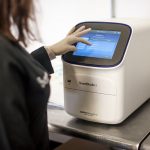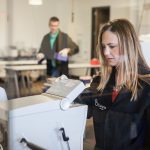Changing Healthcare through the Personalized Medicine Coalition
In our last interview, we spoke with Dr. Bonnie LaFleur of Research Professor of Biostatistics at the University of Arizona BIO5 Institute, about the path to deliver improved decision making tools for patients and physicians. We’re continuing to speak to industry experts from various positions and roles within the life sciences industry to get their perspective on what’s going on with immune-oncology, precision and personalized medicine and where we may be headed over the next few years. In this week’s episode, David Shifrin is speaking with Daryl Pritchard, Senior Vice President of Science Policy at the Personalized Medicine Coalition. You can also listen to the entire recording on Soundcloud with Daryl Pritchard here.
David: Daryl is a geneticist by training and as his title and current role would suggest, he also has extensive policy and advocacy experience. Before we get started, I wanted to highlight something on the personalized medicine coalition website; you make a point that paradigm shifts don’t just happen because the science suggest they should, but takes work to advance and implement a new idea. I’m hoping we can talk a little bit about that today.
Daryl: Thank you, David. I’m glad to participate.
David: Tell us briefly about what you do at the Personalized Medicine Coalition and a little more about your background.
Daryl: The Personalized Medicine Coalition is an advocacy and education organization based in Washington, DC with about 230 members of all different stakeholder types that come together to advance personalized medicine. We work in evidence and policy development, advocacy, education, and awareness to help advance personalized medicine. I bring the scientific perspective to the coalition. Specifically, I run projects and initiatives that are meant to help understand how to integrate precision medicine into healthcare. These help us understand trends and the need for evidence to show the value of personalized medicine so we can drive the paradigm forward in our healthcare system.
David: Let’s talk about digging into the numbers and how the scientific and medical community can present the data in a way that makes sense to all stakeholders. What is your approach to translating the data and science into something that’s communicable?
Daryl: That’s one of the challenges we’re focused on. I think that most stakeholders believe that personalized medicine has the potential to really evolve the healthcare system to be more efficient and effective. What we need now is evidence to show just that. To get this real world evidence, we need to analyze the data that we’re getting. This evidence will really drive the implementation, clinical adoption, and coverage by payers.
David: Can you tell us a little bit about some of the preliminary results?
Daryl: For a classic example, in the case with breast cancer and HER2, you’re seeing an evolution in the standard of care. It’s thought of as a disease type of cancer and different types exist depending on the molecular pathway that’s driving that cancer in neoplastic progression. If we take a look at other cancer types like lung cancer, melanoma, and colorectal cancer, some biomarkers that can help drive targeted treatment pathways are still new, so we need to examine the outcomes for them. We are seeing a great deal of evidence that these targeted strategies work with outside of oncology. For today’s conversation, I’ll focus on oncology, but we’re really seeing personalized medicine breakthroughs in early stages of technology in many different kinds of diseases and indications.
David: In my mind, the term precision or personalized medicine seems future oriented. My perception is that personalized medicine is always in the future, so I think it’s great that you provided an example that says, no, this is actually an application of where it is working and here’s how far we’ve come over the last decades.
Daryl: The Personalized Medicine Coalition has performed a public opinion survey that looked at perception of personalized and precision medicine. We did the survey in 2014 and 2018, and found that more than 60% of the public are not familiar with the term. On the other side, it started to become part of the regular vernacular with the healthcare workforce and physicians. I think there are different definitions and interpretations of implementing personalized medicine.
David: We’re starting to see a shift in the way we think about cancer. What do you think are the most important things over the last decade that have affected both our perception of cancer as well as our treatment of it?
Daryl: The immune-oncology space has taken off and provided a treatment option for many different cancer types that is outside the traditional or standard chemotherapeutic path for cancer care. Although it’s not going to be effective in every patient, it comes with a much lower side effect profile, so there’s been great progress. This has all been based on scientific progress in understanding the molecular mechanisms for our own immune systems to attack tumors and combat cancer. New technologies help our immune system target those tumor cells based on the molecular markers within those cells. What we’re really starting to explore now are the factors that will determine whether a patient will benefit or not from an immune-oncology treatment. As we try to figure this out and the research moves forward, we’re understanding a larger swath of what is going to drive the outcomes for patients that are receiving immunotherapies.
David: Let’s talk about the patients who won’t respond. Just a few years ago with chemotherapy, if you didn’t respond, there’s not a whole lot we could do. I think it’s helpful to people in our audience who are more on the research side, working on these projects, to get a little bit more insight into how the conversations play out.
Daryl: An oncologist will talk to their patient and explain that the standard of care is to do surgery, followed by chemotherapy or radiation therapy, which is the traditional treatment for their cancer type. Then they will explain that over the last couple of years, there has been the discovery of new potential therapies and they are going to test to see if they are eligible. The oncologist will provide an estimate of your potential to be eligible for a targeted therapy. It might only be about 25% of patients, or in some cases 10%.
If it turns out that the patient is not eligible, they fall into the majority of patients that don’t have the molecular marker that indicates targeted therapy. The physician will explain that you don’t have that marker, but we are still going to proceed with what has been the traditional care and your chances of having a good reaction are as they always have been. I think this gives us an additional option for improved outcomes, but doesn’t remove the fact that this is a terrible disease to have.
David: You mentioned earlier that some people define personalized medicine as the technologies being used. What do you see as promising in terms of diagnostics and therapeutics? Conversely, is there anything that may be getting press that you are not super hopeful about?
Daryl: We’re seeing the greatest amount of progress in sequencing and next gen sequencing using a diagnostic approach to analyze all of the potential molecular biomarkers that can inform treatment decisions. This is a big data management challenge because as more and more validated biomarkers get added, we’ve got to communicate that information to doctors. We also have to make clear how to utilize the information to help improve outcomes for their patients. We’re also seeing a lot of promise in liquid biopsy. A blood sample is taken to look for circulating tumor cells and they use the DNA to help determine whether or not targeted therapies or immunotherapies can be used.
The real future in diagnostics is taking these larger data sets, coupling it with other biomarkers such as image analysis, protein, RNA, and gene expression to come up with a larger picture that can help determine the best treatment for a patient. With the advent of learning health systems where we have databases that are accessible by clinics and research labs around the world to put data in and pull data out to do analysis, we’re going to see more complex analytics and diagnostic tools to help guide decisions.
David: What are some of the highlights in that area? What are some of the projects that are going on or some of the institutions or organizations that are really leading the way?
Daryl: There are a lot of different initiatives that have been designed to pull data in the oncology, rare and undiagnosed disease, and pharmacogenomics spaces. These three areas in particular are where we’re seeing an explosion in the use of data to help drive personalized medicine. One example is the Oncology Precision Network, which includes Stanford University Medical Center, Intermountain Healthcare System, and the Providence St. John’s Swedish Cancer Clinic in Washington State. They have an agreement in place to upload all of their cancer data from their molecular tumor boards into one database, which all institutions can use.
I only point out this example because it’s fresh in my mind, but there are many like it. We’re seeing this type of agreement pop up between different institutes around the country and globally. Another database, which is looking at community systems rather than academic systems, is the Flatiron Database, which is a subsidiary of Roche. They’re looking at practice data and linking it to the electronic health records of hundreds and hundreds of community hospital systems around the country. With this data, comes a lot of power to do the analysis, determine what is effective, and determine potential biomarkers moving forward.
David: I do want to touch on clinical trials, their design, and making sure that scientific discoveries are clinically applicable. We’re seeing different trends in terms of how trials are designed. I know patient enrollment is always a huge challenge, so what are some of the advantages of some of these new trial designs in terms of improving outcomes in immune-oncology?
Daryl: The National Institute of Health is making a commitment to basket trials or umbrella trials and has embraced this strategy for pooling data and including patients from many different clinical centers. Individual groups which may be small cohorts in one system can be magnified. It introduces patients to treatment options based on lots of different cases, which is a significant development. The challenge is still finding patients who meet all of the eligibility requirements. I think with more systems getting involved in these basket trials, we’ll start to see that final barrier break down.
These new designs allow us change the very slow process of developing a therapeutic through clinical trials for a single indication. It also allows us to look at more than one indication for that therapeutic, which is especially important when you’re considering biomarker involvement. We’re starting to see the first approvals of tissue agnostic therapies for different cancer types.
If you have a new treatment that targets a specific molecular pathway, it doesn’t matter whether it’s leukemia, lung cancer, bladder cancer, or kidney cancer, you can now develop a treatment that might be effective for all. I think you’re going to see more tissue agnostic approvals in the coming years.
David: I appreciate that insight into the molecular pathway rather than the disease the patient is diagnosed with. We’ve talked about a lot of advances and how far the field has come over the last several years. Let’s look forward. As a scientist and an advocate, where do you want to see things in another decade?
Daryl: That’ll depend on a few things. Obviously I think we’ve seen enough movement in sequencing to say that it will be standard of care in 10-15 years. We’re trying to build that evidence now to talk to policy decision makers to do that. But with the advent of machine learning and big data, there’s a lot of opportunities outside of just sequencing. We can talk about many different biomarker types that can be used in a decision making process. Groups like Alphabet and some other high processed technology companies are looking at data in the healthcare space including markers other than just genetic like image and protein markers. Then, they put it all together through machine learning strategy to determine how this compares to the wide group of patients with this type of cancer and what is the best treatment strategy for them. It depends on how quickly we can develop the big data management processes to handle that level of data as well as the artificial intelligence to help mine it for trends and solutions. I’m confident that we’ll see genomic data being used regularly and standard of care.
We’ll also probably see some other gene expression markers, especially in immune-oncology, become a regular standard of care. I’d like to think that all of these biomarkers are going to come together. To provide an analogy, take a Google map of your cancer and you can look at a tumor and the different pathways that are possible to determine what’s best for you.
David: Daryl, this has been a real pleasure. Where people can go to find out more about you and the work of the Personalized Medicine Coalition?
Daryl: The Personalized Medicine Coalition is based in Washington, D.C. and our website is personalizedmedicinecoalition.org. Here you’ll find all of our materials and information about the Personalized Medicine Coalition and what we’re trying to do to help drive personalized medicine forward.





